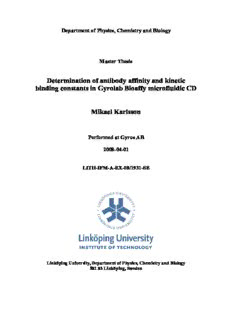
Determination of antibody affinity and kinetic binding constants in Gyrolab Bioaffy microfluidic CD PDF
Preview Determination of antibody affinity and kinetic binding constants in Gyrolab Bioaffy microfluidic CD
Department of Physics, Chemistry and Biology Master Thesis Determination of antibody affinity and kinetic binding constants in Gyrolab Bioaffy microfluidic CD Mikael Karlsson Performed at Gyros AB 2008-04-01 LITH-IFM-A-EX-08/1931-SE Linköping University, Department of Physics, Chemistry and Biology 581 83 Linköping, Sweden Department of Physics, Chemistry and Biology Master Thesis Determination of antibody affinity and kinetic binding constants in Gyrolab Bioaffy microfluidic CD Mikael Karlsson Performed at Gyros AB 2008-04-01 Supervisors Johan Engström Stephan Hoffmann Gyros AB Examiner Olle Inganäs Department of Physics, Chemistry and Biology Linköping University Datum Avdelning, institution Division, Department Date Biomolecular and Organic Electronics 2008-04-01 Department of Physics, Chemistry and Biology Linköping University Språk Rapporttyp ISBN Language Report category Svenska/Swedish Licentiatavhandling ISRN: LITH-IFM-A-EX-08/1931-SE Engelska/English Examensarbete _________________________________________________________________ C-uppsats Serietitel och serienummer ISSN D-uppsats ________________ Övrig rapport Title of series, numbering ______________________________ _____________ URL för elektronisk version http://urn.kb.se/resolve?urn=urn:nbn:s e:liu:diva-11616 Titel Title Determination of antibody affinity and kinetic binding constants in Gyrolab Bioaffy microfluidic CD Författare Author Mikael Karlsson Sammanfattning Abstract Studies of binding reactions are of highest importance in a vast number of areas of biomedicine and biotechnology. A demand for fast and accurate small-volume measurements grows stronger, partly due to the development of therapeutic antibodies. In this report, a novel method for studies of binding reactions of antibodies is described. The use of a microfluidic platform shows promising results in determination of affinity binding constants. Affinities between 1*10-09 and 1*10-11 M have been determined for four TSH antibodies. Reproducibility tests give a CV below 10%, using different Gyrolab instruments and microfluidic CD:s. The method carries the advantages of using solution-based measurements of unmodified molecules. Also an initial proof-of-concept for measurement of binding reaction rate constants shows further usage of the method. The kinetic association rate constant has been determined to 2*106 M-1s-1 for one antibody. The possibility of using this method for screening of antibody libraries is also discussed. Nyckelord Keyword Affinity constants; Equilibrium dissociation constants, Kinetic rate constants; Immunoassay, Monoclonal antibodies, Microfluidics; Gyrolab Bioaffy; Microlaboratory; Compact disc Abstract Studies of binding reactions are of highest importance in a vast number of areas of biomedicine and biotechnology. A demand for fast and accurate small-volume measurements grows stronger, partly due to the development of therapeutic antibodies. In this report, a novel method for studies of binding reactions of antibodies is described. The use of a microfluidic platform shows promising results in determination of affinity binding constants. Affinities between 1*10-09 and 1*10-11 M have been determined for four TSH antibodies. Reproducibility tests give a CV below 10%, using different Gyrolab instruments and microfluidic CD:s. The method carries the advantages of using solution-based measurements of unmodified molecules. Also an initial proof-of- concept for measurement of binding reaction rate constants shows further usage of the method. The kinetic association rate constant has been determined to 2*106 M-1s-1 for one antibody. The possibility of using this method for screening of antibody libraries is also discussed. Table of contents COMMON ABBREVIATIONS..................................................................................................................1 1 INTRODUCTION.................................................................................................................................3 1.1 AIM...................................................................................................................................................3 2 THEORY................................................................................................................................................5 2.1 ANTIBODIES......................................................................................................................................5 2.1.1 Antibody Structure and Therapeutic Use................................................................................5 2.1.2 Antibody Affinity.....................................................................................................................6 2.1.3 Effects Influencing on Affinity Measurements........................................................................7 2.1.4 Studying Affinity.....................................................................................................................7 2.2 IMMUNOASSAYS................................................................................................................................8 2.3 MICROFLUIDIC ANALYSIS SYSTEMS.................................................................................................9 2.4 GYROS’ ANALYSIS PLATFORM..........................................................................................................9 3 ANALYSIS METHOD........................................................................................................................13 3.1 THE IMMUNOASSAY........................................................................................................................13 3.2 REAGENT SYSTEM...........................................................................................................................15 3.3 ANALYSIS EVALUATION.................................................................................................................16 3.4 AFFINITY DETERMINATION.............................................................................................................16 3.4.1 Mathematical Model.............................................................................................................16 3.4.2 Alternative Mathematical Model..........................................................................................18 3.4.3 Reaching Equilibrium...........................................................................................................19 3.5 KINETIC MODEL..............................................................................................................................19 3.6 RESULT INTERPRETATION AND REGRESSION METHOD...................................................................21 4 EXPERIMENTAL SECTION...........................................................................................................25 4.1 MATERIALS AND ASSAY REAGENTS...............................................................................................25 4.2 PREPARATION OF DETECTING AND CAPTURE REAGENTS................................................................25 4.3 STANDARD CURVE..........................................................................................................................26 4.4 UNSPECIFIC INTERACTIONS.............................................................................................................26 4.5 MODELLING WITH MATLAB...........................................................................................................26 4.6 EQUILIBRIUM TIME ESTIMATION....................................................................................................27 4.7 FIRST AFFINITY MEASUREMENTS...................................................................................................27 4.8 CAPTURE REAGENT STUDY.............................................................................................................27 4.9 AFFINITY MEASUREMENTS.............................................................................................................28 4.10 REPEATABILITY TEST.....................................................................................................................28 4.11 CONCENTRATION INFLUENCE ON KD..............................................................................................28 4.12 KINETIC CONSTANTS......................................................................................................................28 5 RESULTS AND DISCUSSIONS........................................................................................................29 5.1 PREPARATION AND EVALUATION OF REAGENTS.............................................................................29 5.2 STANDARD CURVE..........................................................................................................................29 5.3 UNSPECIFIC BINDING......................................................................................................................32 5.4 MODELLING WITH MATLAB............................................................................................................33 5.5 EQUILIBRIUM TIME ESTIMATION....................................................................................................34 5.6 FIRST AFFINITY MEASUREMENTS...................................................................................................36 5.7 CAPTURE REAGENT STUDY.............................................................................................................37 5.8 ADDITIONAL AFFINITY MEASUREMENTS........................................................................................38 5.9 REPEATABILITY TEST.....................................................................................................................39 5.10 CONCENTRATION INFLUENCE ON KD..............................................................................................40 5.11 KINETIC CONSTANTS......................................................................................................................42 6 FURTHER DISCUSSIONS................................................................................................................45 6.1.1 Robustness............................................................................................................................45 6.1.2 How to interpret response....................................................................................................45 6.1.3 Choosing model....................................................................................................................46 6.1.4 Screening of mAb libraries...................................................................................................46 6.1.5 Limitations in Gyrolab Affinity Measurements.....................................................................47 6.1.6 Advantages of the Gyrolab for Affinity Measurements.........................................................47 7 CONCLUSIONS..................................................................................................................................49 8 FUTURE STUDIES............................................................................................................................49 9 ACKNOWLEDGEMENTS................................................................................................................51 10 REFERENCES....................................................................................................................................51 11 APPENDIX A: PROTOCOL FOR LABELLING OF IGG WITH ALEXA 647..........................53 12 APPENDIX B: PROTOCOL FOR LABELLING OF H-TSH WITH BIOTIN............................54 13 APPENDIX C: MATLAB CODE – ILLUSTRATING KD.............................................................55 14 APPENDIX D: MATLAB CODE – SOLVING KINETICS...........................................................57 15 APPENDIX E: MATLAB CODE – CURVE FIT OF KINETICS..................................................58
Description: